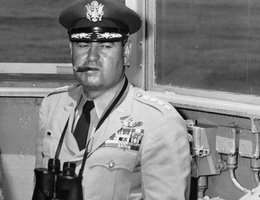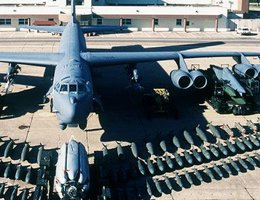
When Gen. Curtis E. LeMay became commander of the Strategic Air Command in 1948 he was appalled at the lack of professionalism in his bomber crews. LeMay rebuilt SAC and, in the process, presided over a huge change in the life of Omaha and Bellevue.

LeMay had been born in Ohio and saw his first plane at the age of four or five. He later said he was excited and ran after it. After graduating from college in 1928 he enrolled in the Army Air Corps. (The separate Air Force was not formed until after WWII.) In the 1930s, he was a decorated navigator and pilot. He took part in the first mass flight of B-17 bombers to South Americans in 1938, and he developed formation techniques that were later adapted to the B-29 Flying Fortresses over the Pacific.
At the end of the war, the General made a dramatic return to the United States, piloting a Super Fortress B-29 on a non-stop record flight from Japan to Chicago. When he arrived in the States, he was assigned to the Pentagon as the first Deputy Chief of Air Staff for Research and Development.
In October, 1947, General LeMay was selected to command the U.S. Air Force in Europe, where he organized air operations for the Berlin Airlift. As the Iron Curtain was descending between East and West Germany, Berlin was left in East Germany. The Soviets wanted to take over the entire city, including the sections of Berlin controlled by America and Britain. The Soviets imposed a blockade on West Berlin, cutting off all land and rail routes into the Western sectors. The Western Allies responded immediately by mounting a tremendous airlift. Under LeMay’s direction, C-54 cargo planes that could each carry 10-tons began supplying the city on July 1. By the fall the airlift was bringing in an average of 5,000 tons of supplies a day. The airlift went on for 11 months — 213,000 flights the brought in 1.7 million tons of food and fuel to Berlin. The Soviets gave up and opened up the land corridors to the West.
Within a year, LeMay was back in the United States to take over of the newly-formed Strategic Air Command at Offutt Air Force Base. He was responsible for all of the nation’s nuclear bombers and saw that an effective deterrence to the Soviets required a strong, threatening nuclear force. One of his first acts was to order a mock "attack" on Dayton, Ohio. All of the SAC bombers missed their targets — most by a couple of miles or so. LeMay was appalled and began an intense program of training and building up air bases around the country and eventually the world. It worked. Many who served under LeMay remember him as a tough leader who still cared for them deeply. Historian Vladislav Zubok says that Russian leader Joseph Stalin was enormously alarmed at the buildup of SAC:
"He [Stalin] had no — had nothing to — had no means to react to it, to deal with this situation. So he came up with desperate countermeasures almost. For instance one of, one of his reactions to that buildup of the SAC forces was to concentrate an enormous armored fist in Eastern Europe and Central Europe. And the idea behind it was — that was when these immense tank armies of, appeared in Central Europe — the idea was, okay, if they want to intimidate us with their, from their air bases, their strike from the air bases, we can intimidate them by our armor groups in Central Europe. If they strike at us, we strike at Western Europe. Of course it was not the same thing, but Stalin could not reach the United States. He was not capable of reaching the United States. No delivery means. Missile designers were still in the very beginning."

At Offutt, LeMay oversaw the building of over 2,000 family housing units for the increasing numbers of service personnel. He worked closely with Omaha civic leaders to build more housing in the city. His daughter, Jane LeMay Lodge, remembers when they moved to Bellevue (the town closest to Offutt) that it was "a town of 1,500 people. Mission, the main street, was the only paved road in town." Bellevue is now the third largest city in the state, behind Omaha and Lincoln, with 50,000 residents.
In nine years as the SAC leader, LeMay built an all-jet bomber force from the remnants of World War II. Under his leadership, plans were laid for the development of an intercontinental ballistic missile capability.
After SAC, LeMay was Chief of Staff of the Air Force and was involved in the Cuban missile crisis. He retired in 1965. He made a short foray into politics when he ran as a vice presidential candidate with George Wallace. General LeMay passed away on October 1, 1990.